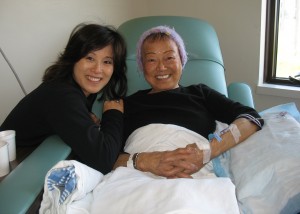Coaching cancer
June 10, 2011
In my 11 years of Co-Active coaching, the toughest coaching client I’ve ever had has been my mom. She had never dared to believe she had any right to ask for what she wanted. Even her own life. So the concept of living a fulfilling life was not merely a “radical act,” but a foreign concept to her.
Mom’s wake-up call came in the guise of lymphoma at age 75. Even though the incurable blood cancer had first gnawed 10 pounds off her delicate 99-pound frame before she was diagnosed, she insisted she was fine: “I don’t need to go to any doctor!” she’d snap with a swat of her hand at us. Ignoring the unwanted had always worked in the past to make it go away. Why not now?
She was finally so weak that she went to the doctor. We learned it was cancer, and it was advancing relentlessly. In spite of three rounds of chemotherapy, a spleen removal (it can block blood production) and regular blood transfusions in the following 18 months, Mom struggled to control the chaos the only way she knew how – by continuing to live exactly as she always had. She kept smoking in secret, but insisted she wasn’t, and refused to exercise every day, but insisted she was.
Mom’s always been a rebel. How else do you distinguish yourself from eight siblings in a traditional Chinese family where boys are born valuable and girls are only there to serve and sacrifice? Revealing her true feelings was an indiscretion worthy of a beating. No wonder she couldn’t receive the outpouring of assistance, love and support from family and friends. Needing help would reveal a humiliating weakness of character.
We have been partners on this journey for almost three years now. Working as a professional Co-Active coach has permitted me the flexibility to be at every lab test, check-up, oncology appointment and chemotherapy treatment. The first two years, I tried to shift her perspective from ‘the cancer is omnipotent’ to ‘I am capable of beating it’ but she clung to her saboteurs for dear life. I tried future visioning to create a possible dream to reach for post-chemo. But giving selflessly was so ingrained in her that all I got back was, “What are you talking about? What on earth is fulfillment?”
Then, last August, her blood levels and immunity plummeted to an all-time dangerous low, she was stricken with a second more aggressive cancer and Dad, her life partner of 53 years, died – all in the same week. She called it a cruel slap in the face and crumbled into helpless tears. The only other time I witnessed Mom cry was when her father was killed in a traffic accident.
The crushing blow jolted her out of her denial. Mom began wondering aloud how she could transform this disease and take back her life. My powerful question that shifted her thinking was, “What would make life worth fighting for?” She whispered, so as not to jinx it: “To travel a bit of the world with my sisters and be at each of my four grandchildren’s weddings.” These dreams transformed her relationship with her disease. Instead of being a victim to it, she began visualizing her body full of goodness powerfully shooting the invading cancer cells.
You know how the most powerful part of coaching happens between the sessions? As coaches, we can’t underestimate our impact. During this final round of chemo she sighed, “I guess it’s time I start loving myself.” Wow! That’s HUGE! Since then, she has been paying attention to her body’s subtle cues, being compassionate with herself, even graciously receiving help. The Future Self/Captain archetype I anointed her is “Queen”. She surrenders in giggles when I ask, “Now, Mom, what would a Queen do?”
The journey has also transformed our relationship from one of a mother shielding and protecting her daughter’s innocence to two adult women relating authentically as friends, mentors and equals. It took months of redesign for Mom to recognize that maintaining a stoic facade was pointlessly taxing and lonely. All my life I’ve been craving to know my mom deeply. That was cancer’s expensive consolation gift.
During our daily phone calls, I consciously create a safe and courageous space for her to explore her darkest emotions. When I ask how she’s feeling now, “fine” has been replaced by checking in with herself and articulating anything from “I think I may be on borrowed time,” or “This has been going on so long, I’m so discouraged,” to “You know, I’m pretty lucky.” The witnessing is helping her become comfortable with this disconnected part of herself. She told me last week that talking about it is helping her to let it go.
Mom’s sixth and final chemo treatment is this week. She’s weak from the toxic cocktails, fatigued by disturbed sleep cycles, and experiencing new side effects. She knows her belief in herself has the greatest influence on her healing, but those old self-berating habits are seductive and it’s taking all of her will to hold onto her optimism. She is conscious of keeping the healing energy flowing through her by focusing on the good in situations rather than worry about the worst-case scenario.
I’m writing this in O’Hare airport waiting for the flight home after leading the Process course. Tears are streaming down my face as I reflect on the perfection of being this weekend’s practice client. Skillful coaches allowed me to voice my own fear of losing Mom. They gave me the judgment-free space to express my anger at God, frustration with her situation and guilt about not being able to make it all better. This clearing enabled me to move through my own emotions to acceptance so I can be present for hers. What is…is. It IS enough to simply love her as she is. She may well be the very reason I was called to this work.
Originally posted in the Coaches Training Institute’s blog: Transforum, June, 2011
New exec tip: take it slow
November 29, 2010
Q: I am the first woman in my organization to be promoted to the executive team. I’m putting a lot of pressure on myself to perform. How can I create a powerful presence so that my perspectives and leadership style will be accepted?
A: First there’s no need to prove yourself. A 19-year study showed that 25 of the top Fortune 500 firms that promoted women into the executive suite were 20-80 per cent more profitable than the medium firms in their industries.
New members provide the team with a valuable point of view that can provide more sound decision-making for a homogeneous team. As part of this team, you are responsible to bring your unique perspective to the table so that it’s heard and considered even though it may not be accepted and adopted.
One of the biggest challenges for any new executive is to step into your new identity so it matches your new role-including viewing corporate issues strategically now instead of tactically. Believing you belong on the team is key since your attitude impacts how you are perceived. If you feel you are fighting to represent an unpopular viewpoint you may come across as defensive. How can you lead so others will follow?
Before rushing to establish your executive presence on the team, assess and manage the relationships. What are the member’s unique drivers, strengths and styles and how are they leveraged on the team? How do members come to agreement on issues? How do they raise and resolve difficult issues?
Collaborate in areas you are already aligned demonstrating your strengths and forging alliances. Credibility and trust take time to develop. Like you, the team needs time to adapt. Enjoy the challenge — you’ve earned it.
Originally published in The Province, November 28, 2010.
It pays to hire female execs
October 25, 2010
Q: None of my top women managers are applying for executive positions. How can I change that?
A: Good idea, since studies reveal companies with more women in the C Suite and on the board financially outperform others by 35 to 65 per cent.
Results are best generated with an initiative actively championed by the CEO that implements a structured hiring policy, targeted development and a workplace that recognizes women’s need to balance work and life.
The easiest way for managers to fill roles is through their networks. Research shows 70 per cent of executives favour promoting men. Make gender parity a top management goal by rewarding it. By identifying particular capabilities to be promoted, current leaders will not merely replicate themselves. Require two qualified women be shortlisted for all leadership roles.
Fill the pipeline with eligible candidates, grooming high-potential women for promotion. Most women downplay their strengths and need to be persuaded to apply. A Hewlett Packard study found women apply for promotions only when they fill 100 per cent of the requirements. Men apply if they possess 60 per cent.
Offer women technical and leadership training. Give them high-profile assignments that partner them with a mentor. Appoint an internal champion to put capable women’s names forward. Coach women on navigating the organization, executive presence and negotiations.
A culture that supports women’s advancement rewards collaboration, promotes work-life balance, less travel, flexible work options and job sharing. It sponsors events during business hours so working mothers can attend.
Finally, measure your success. Track women’s progress, survey them to find out what best supported them and adjust the initiative accordingly.
Originally published in The Province, October 24, 2010.





